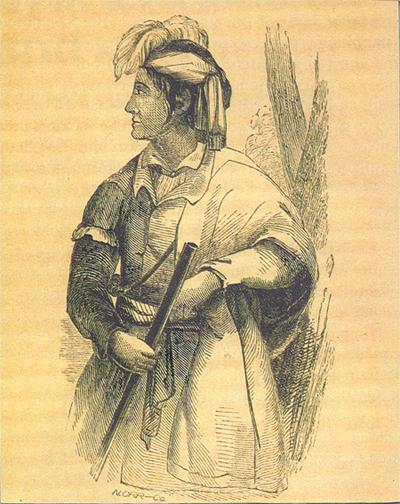Wild Cat (Seminole) facts for kids
Wild Cat, also known as Coacoochee or Cowacoochee (which means "bobcat" or "wildcat" in the Creek language), was an important Seminole leader. He lived from about 1807 or 1810 to 1857. Wild Cat played a big role in the later parts of the Second Seminole War. He was also the nephew of another famous Seminole chief, Micanopy.
Contents
Wild Cat's Early Life and Family
Historians are not completely sure when or where Wild Cat was born. Many believe he was born around 1807 on an island in Lake Tohopekaliga. This lake is south of what is now Orlando, Florida. Other experts think he was born around 1810 in a Seminole village called Yulaka. This village was along the St. Johns River in northern Florida. His parents were King Philip and his wife. Some also suggest he was born near modern-day Apopka, Florida. It is thought that Wild Cat might have had a twin sister who passed away at birth. Being a twin was special in his tribe. The Seminole people believed twins had unique gifts.
Tensions and the Second Seminole War
In 1821, the United States bought Florida. This led to more arguments between the Seminole people and new settlers. The Seminole encouraged enslaved people from Georgia to escape to Florida. This made it harder for European Americans to settle in areas that were once Seminole land.
When the Second Seminole War began, Wild Cat was about 19 years old. He quickly became a strong leader. He led groups of Seminole and Black Seminole fighters. His father was captured in 1837 and held at Fort Marion.
Wild Cat's Escape from Prison
In October 1837, Wild Cat went to meet American soldiers. He wore a special peace headdress. He said he was a messenger from the war chief Osceola. He talked with Colonel Thomas S. Jesup. The American leaders agreed to peace talks. But when the Seminole leaders arrived, Jesup ordered their arrest.
Wild Cat was put in prison at Fort Marion. But he did not stay there for long! He escaped with 19 other Seminole warriors. They reportedly did not eat for six days. This made them thin enough to slip between the bars of their jail cell. Then, they dropped from the high walls into the moat outside the fort. It was a daring escape!
Leading the Fight and Peace Talks
After Osceola was captured, Wild Cat became a main leader in the war. He fought alongside other chiefs like Alligator and Arpeika. They faced Colonel Zachary Taylor at the Battle of Lake Okeechobee on December 25, 1837. The battle did not have a clear winner. After the fight, Wild Cat and his people moved into the Everglades.
In 1841, Wild Cat's father died while being moved to Indian Territory. Two years later, Wild Cat agreed to meet with American officials for peace talks. He talked with Major Childs, who was Lieutenant William T. Sherman's commander. This meeting happened at the Indian River post of Fort Pierce. Wild Cat agreed to be moved to Fort Gibson in Oklahoma's Indian Territory. About 200 of his followers went with him. He felt sad about having to surrender. He reportedly said, "I was in hopes I would be killed in battle, but a bullet never reached me."
Challenges in Indian Territory
In 1843, Wild Cat traveled to Washington, D.C. with Alligator. They were part of a Seminole group. They hoped to get money and help for their people. The Seminole reservation had suffered from floods. They also faced raids from neighboring Creek people. The Creek captured free Black people and Native Americans. They sold them to slave owners in the South. This was very hard on the Black and Native American Seminole people. Conditions continued to get worse until 1849.
Moving to Mexico and Final Years
In 1849, Wild Cat decided to leave the reservation. He took about 100 followers with him. This group included Seminole and Black Seminole people, even some who had escaped slavery. They traveled to Texas. About 1,000 Kickapoo people joined them there.
Wild Cat's group eventually created a new community in Mexico. The Mexican government gave them land. This was a reward for their help against Apache and Comanche raiders. Wild Cat became a Colonel in the Mexican army. He lived with the Seminole people in Alto, Mexico. He passed away in 1857 from smallpox. His son, Gato Chiquito (which means "Young Wild Cat" in Spanish), became the new chief.
Wild Cat's Legacy
On May 29, 2012, an application was made to the U.S. Bureau of Geographic Names. The goal was to name a group of unnamed islands on the Florida East Coast after this important chief. These islands are now known as Coacoochee Island.
Quotes
- "I speak for myself, for I am free. Each of the others also speak for themselves. We are a choir of voices that will drown out your lies."


